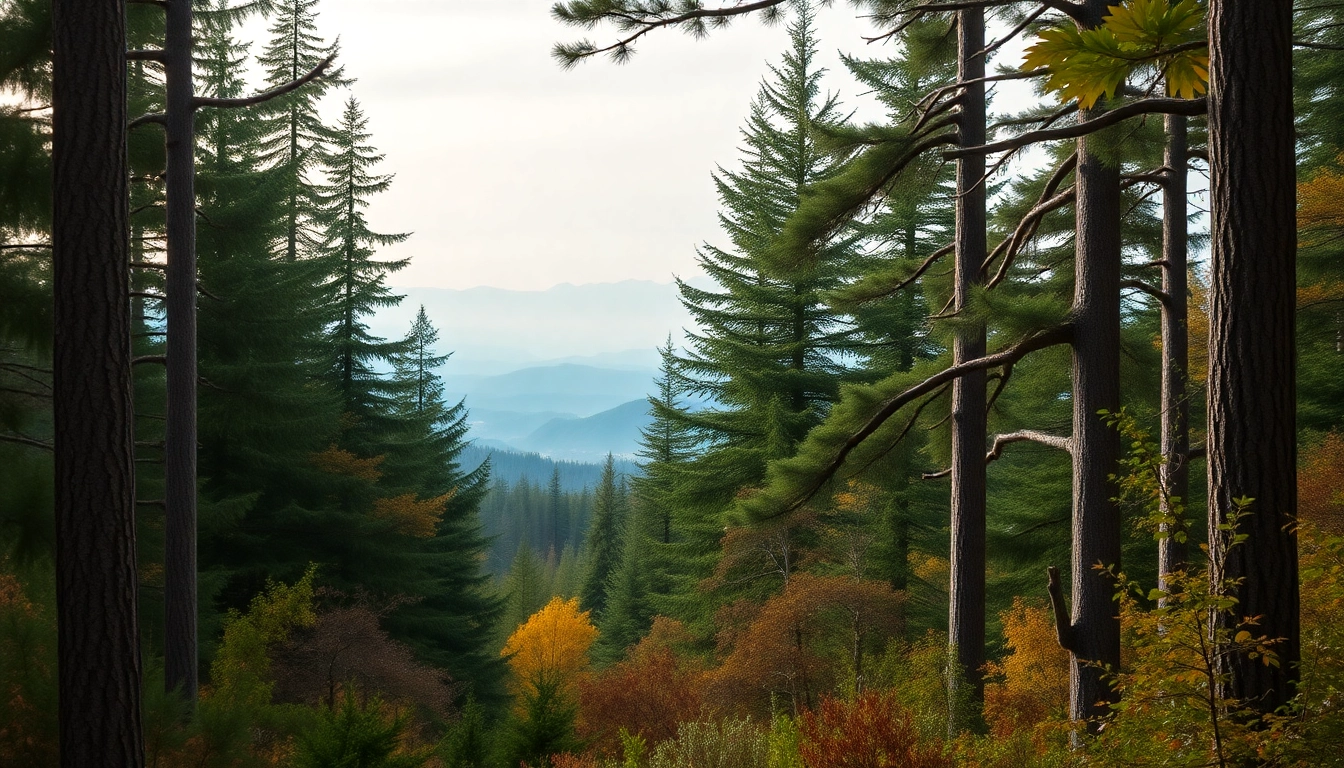Overview of the Taiga Biome
The Taiga, also known as the boreal forest, is one of the largest biome types on the planet, spanning across Canada, Alaska, Russia, and parts of Northern Europe. This unique ecosystem is characterized by its dense forests primarily made up of coniferous trees. Despite its vast expanse, the Taiga remains one of the most understudied biomes, offering critical habitats for diverse flora and fauna while also playing a significant role in global climate regulation. Understanding the intricacies of the Taiga is essential for ensuring its conservation and appreciating its ecological importance. For more in-depth exploration, refer to the Taiga ecosystem.
Defining Characteristics of Taiga
The Taiga biome is predominantly characterized by its cold climate, coniferous forests, and unique soil types. The trees in this biome are predominantly evergreen conifers, such as spruces, pines, and firs, which are well adapted to the harsh conditions of the area. These trees have needle-shaped leaves that minimize water loss and are coated with a waxy substance to protect them from extreme cold. The Taiga experiences a distinct seasonal cycle, with long, cold winters and short, warm summers. The soil in the Taiga is typically acidic and poor in nutrients, primarily due to the slow decay rate of organic matter.
Geographical Distribution of Taiga
The Taiga predominantly covers regions across the northern latitudes, stretching in a broad band across Eurasia and North America. Geographically, it begins just south of the Arctic tundra and extends to the northernmost parts of the temperate forest biome. This vast region is crucial not only for its biodiversity but also for being an essential carbon sink that helps moderate global climate conditions. The largest expanses of Taiga can be found in Russia, accounting for nearly 60% of the total Taiga coverage, while Canada and Scandinavia also host significant portions of this biome.
Climate and Weather Patterns in the Taiga
The Taiga is characterized by a subarctic climate, with significant temperature fluctuations between seasons. Winters in the Taiga can be extremely harsh, with temperatures often plunging below -30°C, while summers can see temperatures rise to 20°C or higher. Precipitation varies, averaging between 400 to 1000 mm annually, predominantly as snow during the winter months. The Taiga’s climate plays a vital role in shaping its ecological dynamics and influencing species adaptations. The seasonal thawing of the soil during spring encourages bursts of life, as flora and fauna emerge from the dormancy of winter.
Flora and Fauna of the Taiga
The Taiga is rich in both flora and fauna, with unique species that have adapted to its specific climate and environmental conditions. The ecosystem supports a myriad of plant and animal life, creating a dynamic and interdependent community within a sometimes harsh environment.
Unique Plant Species Found in Taiga
The Taiga is home to distinctive plant species that are well-adapted to its cold and nutrient-poor conditions. The dominant trees include species like the Norway Spruce, Larch, and Eastern Hemlock. Understory vegetation typically consists of shrubs, mosses, and lichens. These plant species have developed numerous adaptations such as shallow root systems to access moisture and soil nutrients, and the ability to photosynthesize efficiently during the short growing season. Additionally, some plants can tolerate extreme temperatures and heavy snowfall, illustrating the resilience of life in the Taiga.
Wildlife Adaptations in the Taiga
The wildlife in the Taiga includes a wide array of species that have adapted to the biome’s challenging conditions. Notable mammals include moose, caribou, and wolves. Many of these animals possess thick fur, large body sizes, and the ability to store fat to survive long winters. Birds, such as the Great Grey Owl, have keen hunting skills to thrive in the Taiga’s unique ecosystem. Additionally, many animals in the Taiga undergo seasonal behaviors, such as migration or hibernation, to cope with the extreme seasonal changes.
Food Chain Dynamics in Taiga Ecosystems
The food chain in Taiga ecosystems is complex and interconnected, reflecting the delicate balance of various species. Primary producers, including coniferous trees and ground-level plants, form the base of the food chain, supporting herbivores such as deer and hares. These herbivores, in turn, serve as prey for carnivores like bears and wolves. Decomposers, including fungi and bacteria, play a crucial role in nutrient cycling, breaking down dead organic material and enriching the soil, allowing for the growth of new vegetation. Understanding these dynamics is essential for conservation efforts, as disrupting one element of the chain can have cascading effects throughout the ecosystem.
Environmental Challenges Facing the Taiga
Despite its resilience, the Taiga is facing numerous environmental challenges that threaten its stability and biodiversity. These challenges stem from both natural phenomena and human activities, which can have lasting impacts on this vital biome.
Impact of Climate Change on the Taiga
Climate change poses a significant threat to the Taiga biome, with rising temperatures leading to altered precipitation patterns and the melting of permafrost. These changes can result in increased forest fires, pest outbreaks, and shifts in species distributions, ultimately affecting the intricate balance of the ecosystem. The northward migration of certain species due to warming temperatures may also disrupt local food chains and species interactions, leading to decreased biodiversity over time. Addressing climate change through global initiatives and local conservation policies is crucial for protecting the Taiga.
Deforestation and Its Effects on Taiga
Deforestation in the Taiga, primarily driven by logging and land development, has far-reaching consequences for the environment. The removal of large expanses of trees can lead to soil erosion, disrupted habitats, and altered water cycles. Furthermore, the loss of tree cover reduces the region’s capacity to sequester carbon, contributing to global warming. Sustainable forestry practices, reforestation efforts, and stricter regulations are imperative to mitigate these adverse effects and ensure the long-term health of the Taiga’s forests.
Human Activity and Taiga Degradation
Human activities such as mining, industrial development, and agriculture also pose threats to the Taiga. These activities can lead to habitat destruction, pollution, and the introduction of invasive species that may outcompete native flora and fauna. The establishment of unsustainable practices can further exacerbate the decline of this critical biome. Increasing awareness and promoting harmonious interactions between humans and the environment can help protect the Taiga’s natural resources.
Conservation Efforts for the Taiga
Various conservation efforts are underway to protect and restore the Taiga, focusing on sustainable management and the preservation of its unique biodiversity. These efforts involve collaboration among governments, NGOs, and local communities to create effective conservation strategies.
Protected Areas and Reserves in the Taiga
Numerous protected areas and reserves have been established within the Taiga to safeguard its ecosystems and biodiversity. These areas serve as vital sanctuaries for endangered species and help maintain ecological integrity. Examples include national parks and wildlife reserves that restrict logging, encroachment, and other harmful activities. By creating these protected zones, governments aim to offer refuge to both flora and fauna while allowing for research and education regarding the Taiga’s importance.
Restoration Projects for Taiga Ecosystems
Restoration projects play a vital role in recovering degraded areas of the Taiga. These initiatives often involve reforesting areas that have been subject to deforestation and rehabilitating damaged habitats. Restoration efforts may include planting native tree species, controlling invasive species, and implementing soil and water conservation techniques. Engaging local communities in these restoration projects fosters a sense of ownership and encourages sustainable practices that benefit both people and wildlife.
Role of Indigenous Communities in Taiga Conservation
Indigenous communities have a profound understanding of the Taiga and its ecosystems, having lived in harmony with the land for generations. Their traditional ecological knowledge is invaluable in conservation efforts, offering insights into sustainable resource management and biodiversity preservation. Collaborating with Indigenous peoples can lead to more holistic approaches to conservation, integrating cultural practices and methodologies that prioritize the health of the Taiga. Empowering these communities through rights recognition and involvement in decision-making processes is crucial for effective conservation.
The Future of the Taiga
The future of the Taiga hinges on collective efforts to address environmental challenges and promote restoration and sustainability. Strategies that focus on research, community engagement, and innovative conservation practices will be vital for preserving this unique biome.
Research and Innovations in Taiga Conservation
Ongoing research is essential to deepen our understanding of the Taiga and its response to environmental changes. By studying the effects of climate change on Taiga species and ecosystems, scientists can develop and implement innovative conservation strategies. Technological advancements, such as remote sensing and data analysis, support the monitoring of ecosystem health and biodiversity, allowing for informed decision-making regarding conservation policies.
Community Engagement in Taiga Preservation
Engaging local communities in Taiga preservation efforts fosters stewardship and brings awareness to the importance of conservation. Education programs about local flora and fauna, ecological awareness campaigns, and the promotion of eco-tourism can empower communities to protect their natural environment. Collaborative efforts among various stakeholders, including governments, NGOs, and local inhabitants, are essential for creating lasting change.
Long-term Goals for Taiga Sustainability
To ensure the sustainability of the Taiga, long-term goals should focus on protecting biodiversity, implementing sustainable resource management, and addressing climate change impacts. Establishing clear conservation targets, expanding protected areas, and fostering international cooperation will be essential for safeguarding this important biome. By balancing ecological integrity with human needs, we can work towards a future where the Taiga thrives as an essential part of our planet’s ecological legacy.



